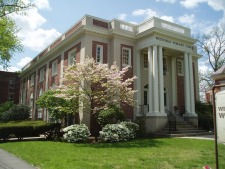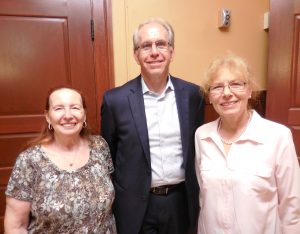WESTFIELD – The Community Preservation Committee (CPC) heard a request for funding for accessibility rehabilitation from the Westfield Woman’s Club on Thursday evening. Susan West, president of the WWC Foundation asked the committee to consider helping the historic building, built in 1914 and located at 28 Court Street to become handicap accessible.
“People can’t come to events. Members can’t access the building,” West said.

The Westfield Woman’s Club needs an upgrade to the accessibility for the building entrance. (WNG File Photo)
Westfield Woman’s Club president Lillian Hebert said through the years, everyone has wanted to come to the theater at the club. She said most of the complaints they receive are around accessibility, including programs that are held in the reception room downstairs. “We have tried other avenues,” Hebert said.
CPC chair Joe Muto said that Community Preservation Act funds may be used for Americans with Disabilities Act (ADA) access, but that the committee has previously focused on the building envelope. The request by the WWC was for an LULA/lift and exterior entrance from Holland Street to the theatre and reception room, a lift to the stage in the theater, an ADA accessible restroom in the basement and additional life safety upgrades, for a total request of $169,830.
West said the plan includes pulling out windows to create an external shell using a piece of the façade for the entrance to the elevator, so the look of the building is not significantly changed. She said the club hired Architectural Insights of Palmer who created the plan, and are asking for 90% of the funds. West said they would fundraise for the remaining funds.
Robert Haveles of Architectural Insights said the nature of that era of building was to make a design statement by elevating the first floor, which increased the basement ceiling and windows, but which created accessibility challenges. He said the most practical solution was the external enlargement on Holland Street, the most accessible side of the building.
West said an additional bathroom in the basement level that is handicap accessible would be less expensive than making existing bathrooms ADA accessible.
Park and Recreation CPC representative Vincent Olinski asked if the amount of the request triggered any other fire codes, to which Haveles replied that it didn’t. “We’ve had other groups come forward with requests that have had asbestos issues, and (the work ended up) three times the original cost,” Olinski said. Haveles said they hadn’t checked for hazardous materials as yet.
Olinski also asked if they had applied for Community Development Block Grant funds. Community Development director Peter Miller responded that since the Woman’s Club was a private membership organization, they didn’t qualify for CDBG funds.
“My understanding has always been to use CPA funds for public projects. I see it (the request) akin to someone with a historical home asking us to paint it for them,” said CPC vice chair Thomas E. Sharp from the Conservation Commission.
“I’m not a member, but I go to every play. I think it’s not just a private entity,” said Cynthia Gaylord, CPC member from the Historical Society.

Lillian Hebert, president of the Westfield Woman’s club, Robert Haveles of Architectural Insights and Sue West, president of the WWC Foundation at the meeting on Thursday. (Photo by Amy Porter)
Hebert said the building is open to the public for rentals, but West said they have had to limit rentals to a degree because of the accessibility issues.
Ward 4 Councilor Mary O’Connell said that she previously served on the WWC board. “I can’t tell you how many people use it for christenings and family events,” she said, adding that there is an interest in using the building for events like public debates, but that the accessibility gets in the way.
O’Connell also called the building an anchor of the city that was supposed to be a mirror image of the Athenaeum.
“You’ve done a phenomenal job maintaining the building,” Muto said. He asked if the WWC was a 501(c)3 non-profit, and West said the Foundation is for raising funds for the WWC.
Westfield Housing Authority representative Daniel Kelly called the request “a great project.”
“I’m a firm believer that anyone who puts in an application, we should help,” Kelly said, adding that he didn’t agree with Sharp’s rejection of using CPA funds for private entities.
City planner Jay Vinskey said the WWC would receive a Historic deed restriction with the funds that would prevent changes to the exterior of the building in perpetuity. Kelly also said that he agreed there might be issues with asbestos and lead paint.
“I think you’ve certainly put the work into this. As many have said, it is an anchor of the downtown,” said Gaylord, adding that the building is listed on the State Register of Historic Places at the Massachusetts Historical Commission.
Olinski asked if supporting the project meant that the CPC would follow past precedent and support any work on the exterior, but not support any work on the interior. Muto said that would be his feeling.
“They are all eligible under ADA, but I think the issue is private property,” Vinskey said.
“For all intents and purposes, it’s a public building,” O’Connell said. Haveles added that under the Americans with Disabilities Act, any building that is open for public access is considered public.
West said the Westfield Commission for Citizens with Disabilities has also approached them and said they couldn’t keep holding inaccessible events.
“Are we able tonight to support the elevator,” asked Gaylord. Muto said they could put that wording in a motion. The cost of the exterior elevator in the plan was listed as $130,000.
CPC Planning Board alternate William Carellas said that they might run into some sort of overage in the contract, and might want to build in overage in the grant. A motion was made to fund the project at $135,000 for the handicap LULA lift exterior addition and preliminary study and design. The project was unanimously approved.
“Now it goes to the City Council,” Olinski said, adding that the next meeting would be on August 24, where it would be sent to a sub-committee for review.

